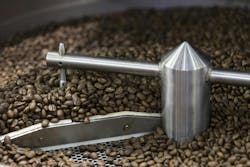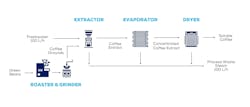Achieve more uptime in the food and beverage industry with asset performance management strategies
The bold and creamy taste that coffee connoisseurs have come to expect from an instant café macchiato requires optimal performance of the manufacturer’s production line. Like many of today’s coffee beverages, instant coffee is produced through a manufacturing process. Production phases for these coffee drinks include grinding the coffee beans or extracting pure coffee for a shot of espresso. They also include blending coffee with other products to create mixed beverages.
To produce instant coffee, a manufacturer starts with a roaster to get the flavor of the beans just right. The beans then move to a grinder to produce coarse crystals for the next phase of production. After adding fresh water, coffee is placed through an extractor and then an evaporator. The concentrated coffee is then dried before it is ready for market. This process is shown in Figure 1.
Smooth production of instant coffee requires regular maintenance and periodic adjustments to prevent bottlenecks and unwanted downtime. One way that operational experts accomplish this is by using asset performance management (APM) strategies. Derived from insights found in operational data, these strategies help them improve operational efficiency, reduce downtime and increase longevity in the assets found in industrial coffee production.
What is APM?
APM is a strategic approach used to optimize the performance of physical assets. The objectives of APM are to enhance operational efficiency, reduce costs and improve safety. This is accomplished by using practices, technologies and methodologies that help maintain and operate production assets effectively.
There are several components to an APM strategy including:
- Real-time monitoring: Engineers use sensor-generated data to monitor operational status and health. Real-time monitoring continuously assesses the condition of assets and helps predict potential failures.
- Predictive maintenance: Operational data provides insights into when equipment might fail or require maintenance. Engineers can use this information to schedule maintenance activities proactively and prevent unplanned downtime.
- Reliability-centered maintenance (RCM): Engineers use this method to determine which maintenance strategies will be most effective based on the reliability and importance of each asset.
- Enterprise asset management (EAM): Operational experts use EAM strategies to manage the lifecycle of physical assets from design and procurement to decommissioning.
For example, real-time monitoring provides better visibility into asset health and performance. This includes not only the early detection of anomalies and potential failures, but also identification of degraded asset conditions. When failures do happen, a deep dive into operational data helps engineers identify the underlying root cause. They use this information to prevent future anomalies, which, in turn, leads to more robust and reliable asset performance.
For advanced anomaly detection and failure prediction, data scientists can easily collaborate with engineers and apply algorithms and other statistical methods for the creation and training of machine learning models. Once deployed into operations, these models are used in conjunction with real-time monitoring for a complete overview of asset performance.
Using APM to prevent bottlenecks
In the case of instant coffee production, the extraction, evaporation and drying phases have different cycle times. Bottlenecks can occur at any phase, but they are especially likely at the extraction phase. To prevent these bottlenecks and unwanted downtime from happening, engineers periodically need to perform line balancing.
Line balancing plays an important role in increasing efficiency in instant coffee production. By evenly distributing work tasks across production lines, engineers can minimize downtime and reduce the risk of bottlenecks. Line balancing ensures that each line operates at its maximum capacity.
In one case, where the bottlenecks were occurring at the extraction phase, engineers used TrendMiner’s advanced industrial analytics platform to provide insights on instant coffee production. They looked for periods where the extraction process of a batch was finished before the evaporator phase completed on the previous batch. As a result of this search, they discovered that a tank at the extractor phase was filling before the evaporated phase had completed.
This was a sign that the lines needed to be balanced. Engineers then created dashboard monitors to get an overview of the production of each line. Next, they made a new tag that calculated the rate of change of each tank. Finally, they created another new tag that calculated the derivative of the tank level and saved that tag as a new dashboard monitor, which is shown in Figure 2.
When tank capacities began to reach their maximum, engineers knew it was time to balance the lines. The result was a 5.2% increase in instant coffee production.
A blend of operational insights
The perfect cup of instant coffee starts long before the water is set to boil. By harnessing the power of operational data and using APM strategies, operational experts achieve predictive quality and substantial cost savings in instant coffee production. They also help keep everyone’s morning coffee brewing.
Pablo Sánchez is a data analytics engineer at TrendMiner. He holds a bachelor’s in chemical engineering from the University of Cantabria and a master’s from the University of The Basque Country. Prior to joining TrendMiner, Pablo was a production engineer and digitalization specialist at Nestlé.
TrendMiner



